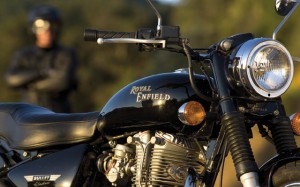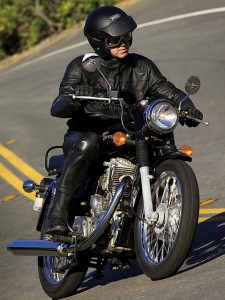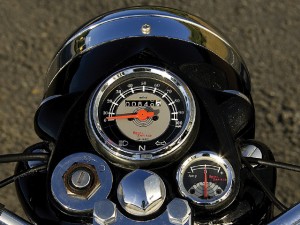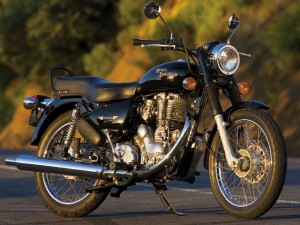
Vintage bikes are so cool! Show up at a bike event with a nicely restored classic and you’ll likely garner more attention than some guy on his $40,000 custom. A custom starts at today and works its way forward aggressively into unknown territory; a restoration starts in the comfortable past and luxuriates there, reminding us of grade school, Ozzie and Harriet and Barney Fife.
The problem, of course, is that the restoration process usually requires 1) cubic dollars, 2) cubic mechanical knowledge and 3) an extensive network of contacts for locating those hard-to-find parts. Wouldn’t it be great if you could buy a brand-new vintage bike that came with a warranty and a ready supply of new parts? Well, you can.
The Royal Enfield Bullet 500ES Electra X single is essentially a new/old classic. The story goes that the Bullet was introduced by Royal Enfield in England as a 350 single back in 1949, and became a 500cc in the 1950s. The nation of India began buying Bullets for its military, so in 1956 Enfield established a factory in Madras to build the bikes. When the parent company went out of business in the early 1970s, the Indian plant remained-and today continues to produce what are essentially brand-new 1950s-era British singles complete with a warranty, spare parts and many important updates.
While they look like (and in many ways are) classics, over the years Enfield’s Bullets have acquired a 12-volt electrical system, electric starting and a five-speed transmission. Among its models are the Classic (which resembles a 1950s motorcycle, $4,795), the Sixty-5 (which is styled like a 1960s bike, $4,895) and the new-for-2006 Electra X 500 single ($4,995) that we test here; it resembles a ’70s model. It incorporates the front disc brake that is optional on some models, and it also introduces the Lean Burn engine.

Despite its updates, a walk around a new Bullet 500 will transport you back in time. The 500 ES Electra X touchstones include wire wheels, a simple two-piston front disc brake with a drum rear, fork gaiters and a flat dual seat, and the nacelle housing its speedometer and ammeter is reminiscent of an earlier day. A four-stroke engine with such a big barrel and generous fin area reminds one of the ’50s, but there’s also the rough castings and that brownish, crinkly patina of age usually seen only on classic bikes. It has chain final drive, of course, but with none of that fancy O-ring business. The Bullet also sports‚ oil grunge between some fins? Oil spots on the floor? A fine film of oil on the chain guard and rear wheel? Oh, my‚ perhaps some aspects of the Bullet are a little too classic.
The ES Electra X has a 499cc overhead valve engine with a bore and stroke of 84.0 by 90.0mm, and a compression ratio of 8.5:1. Enfield rates the bike at 23 horsepower at 5,000 rpm, which seems reasonable to my seat-of-the-pants dyno. This model has an electronic ignition, and its Lean Burn engine is new from the cases up. The included valve angle has been reduced from 80 to 55 degrees for better flow, and the combustion chamber has been made more compact to promote faster, cleaner burning. Repositioning the valves allows the spark plug to be more centrally located to shorten the flame path. The pushrod-actuated valve train has been lightened and strengthened, and the bike also gets other improvements in bearings and lubrication in the interest of longer engine life. The compression release activates automatically with the electric starter, or you can use the manual release with the kickstarter. Finally, the Pulse Air System helps it meet most emissions requirements-but, unfortunately, not California’s. The bike won’t be sold there.

For long-time riders the first impression of the Enfield will likely be “Gee, it’s small!” With a 53.5-inch wheelbase and a 412-pound wet weight, this bike feels like the throwback that it is. Even with the manual compression release, the kickstart lever on the right (if you wish to try it) will give your leg a workout. Rather, pull out the choke lever (hidden behind the float bowl of the 28mm Mikuni CV carburetor) and thumb the electric starter.
The engine turns over slowly, catches and breaks into a slow, thrumming idle as the ammeter immediately swings to the plus side. The cable-actuated clutch has a light-to-moderate pull as you toe the bike in gear, let out the clutch and putter away. The handlebar is low and flat, and the bike is so short that its very upright seating position screams “That ’70s bike!” Though wide, the seat foam is too soft-it compacts and settles the rider into a puddle of moosh through which he or she can still feel the vibrations coming through the seat.
The Bullet will transport you back in other ways. With its 90/90-H19 Avon RoadRunner front and 100/90-V19 Avon Super Venom rear tires, you’ll suddenly recall in the curves what a set of really narrow tires feels like. Combined with a short wheelbase they make handling quick to the point of being twitchy.
Power is understandably mellow, and as the engine revs (there is no tach) the rider feels a vibration band mainly through the seat and less so in the grips at medium to high revs. The front disc brake is medium-effort and the lever nonadjustable, but it delivers decent stopping power in keeping with the bike’s performance level; the rear is an acceptable drum brake. We usually associate reservoir shock absorbers with high-performance motorcycles, but the Bullet’s deliver a jarring ride on rough pavement. Top speed is around 72 mph indicated, and fuel mileage is up in the 60s. Sound level coming through that overly long, chromed muffler is equally mellow-in keeping with the bike’s performance level.
Updates aside there’s nothing fancy about the Enfield: no fuel injection, no adjustable levers, not even a tripmeter. I bent the key trying to open the toolbox. But it does have a centerstand, and the tank badge is way cool. Still, for going out for a putt on the backroads on a sunny afternoon, the Bullet is a very satisfying ride. Treat it with the respect due your elders, and it should provide reliable transport. With that said, I’ve got to report that previously we had an Enfield Classic to test, which with its ’50s styling garnered a huge amount of attention. Everywhere I rode, people were giving me the thumbs-up, saying “Nice restoration!” and asking “What year is it?” However, the bike had an intermittent electrical short, and once when I pulled out to pass a car at about 60 mph the primary chain broke, which lunched the crankshaft and holed the case; warranty is 12 months, unlimited miles. By contrast, the Electra X’s ’70s styling garnered hardly any attention, but the bike performed flawlessly.

Would I have an Enfield? So long as the dealer was reliable and close enough, and I had other motorcycles to handle my serious sporting, touring and commuting needs, yes. I’d enjoy an Enfield for Sunday afternoon toots into the countryside, errands around town and running over to bike nights. But all need to be aware that it truly is a vintage machine, and treat it as such. Contact the company at www.enfieldmotorcycles.com.
If you’re interested in the 2006 Royal Enfield Bullet 500 ES Electra X, you might also be interested in Rider‘s 2010 Royal Enfield Bullet C5 Classic review, or our 2008 Enfield Bullet 500cc Classic review.







